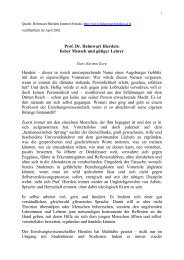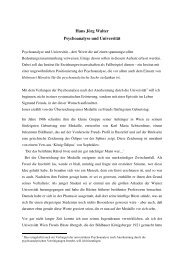Download pdf - Universität Innsbruck
Download pdf - Universität Innsbruck
Download pdf - Universität Innsbruck
Sie wollen auch ein ePaper? Erhöhen Sie die Reichweite Ihrer Titel.
YUMPU macht aus Druck-PDFs automatisch weboptimierte ePaper, die Google liebt.
Some of the social logics of sharing 51<br />
innocent child,” who is said to exist in a state of “pristine innocence” until spoilt “by the<br />
violence and ugliness that surrounds [him]” (James, Jenks, & Prout, 1998, p. 14).<br />
Having discussed sharing in Web 2.0 and some of the aspects of sharing economies of<br />
production and consumption, we turn now to a third sphere of sharing, that of the therapeutic<br />
narrative.<br />
4. The therapeutic narrative<br />
The therapeutic narrative (or discourse, or culture) sometimes refers to the psychologization<br />
of problems, or the spread of psychological diagnoses into everyday life. Here,<br />
though, the term is used to refer to the spread of the principles of psychology into personal<br />
relationships, and the way we understand our selves: for instance, that the structure of our<br />
personality is a function of significant events in our childhood and early family life (Illouz,<br />
2007, see esp. Chapter 1; 2008, see esp. Chapter 3). In the present context, though, what is<br />
most important is that the therapeutic narrative incorporates the idea that the way to solve<br />
interpersonal problems is to talk about them and that, relatedly, the modern intimate relationship<br />
is formed and sustained through communication (Cameron, 2000). If the constitutive<br />
activity of Web 2.0 is the sharing of links, information, or updates, we might say<br />
that the sharing of emotions is the constitutive activity of the contemporary intimate relationship.<br />
In her book, Saving the Modern Soul, Illouz, albeit unintentionally, makes clear the centrality<br />
of the act of sharing to therapeutic culture (Illouz, 2008). For instance, she describes<br />
the therapeutic ideal as implying “the injunction to share all needs and feelings” (p. 227).<br />
Many of the various interviews and self-help books she quotes as she makes her arguments<br />
refer to the sharing of emotions. For instance, a marriage counselor is quoted as saying:<br />
“In over 25 years as a psychiatrist working with couples and young families,<br />
I have found that an imbalance of this kind in one or both partners can lead<br />
to two kinds of trouble in a marriage: either there is too much sharing and<br />
empathy between the partners (yes, there is actually a thing as too much!) or<br />
there is too little sharing and not enough empathy” (p. 139).<br />
Sex and intimacy thus involve sharing feelings, but not in a haphazard way: we have to<br />
share our feelings to the correct degree, or else our relationship will be considered pathological.<br />
Similarly, in The Normal Chaos of Love, Beck and Beck-Gernsheim write: “As research in<br />
social history shows, with the transition to a modern society came a far-reaching transformation.<br />
What used to be a team sharing the work [i.e. pre-modern agricultural families]<br />
has turned into a couple sharing emotions” (Beck & Beck-Gernsheim, 1995; see also<br />
Giddens, 1991 on the pure relationship).
















